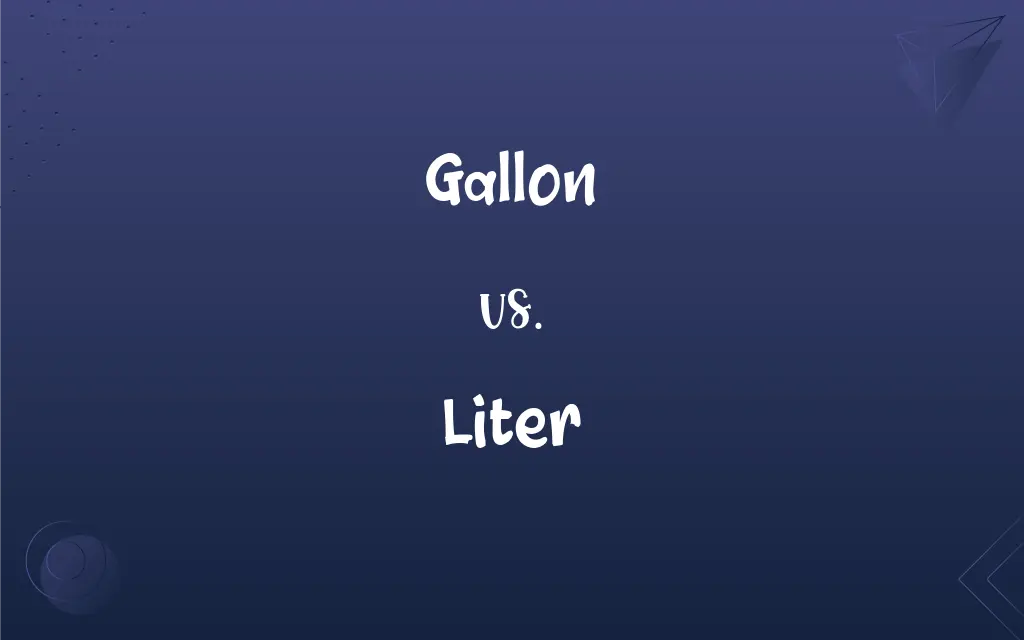Gallon vs. Liter: What's the Difference?
Edited by Aimie Carlson || By Janet White || Updated on October 19, 2023
"Gallon" is a unit of volume used in the US customary system, while "Liter" is a metric unit of volume. Both measure liquid capacity but differ in size.

Key Differences
A "gallon" is a unit of measurement for liquid capacity in both the US customary units and the British imperial systems of measurement. The US gallon, defined as 231 cubic inches (about 3.785 liters), is used in the United States and some Latin American and Caribbean countries. Conversely, a "liter" is a unit of volume in the metric system, equal to one cubic decimeter or 1,000 cubic centimeters (approximately 0.264 gallons), and is used in most countries around the world, including Europe and those using the International System of Units (SI).
While "gallons" are often used in daily activities such as fuel consumption in the United States, "liters" are more common in scientific contexts and in countries using the metric system. For instance, in the US, beverage containers might be labeled in gallons or fractions thereof, whereas in Europe, you would find them labeled in liters.
The concept of a "gallon" can vary between countries, with the UK gallon being larger (approximately 4.546 liters) than the US gallon. On the other hand, a "liter" remains consistent worldwide as it's based on the metric system, which is an international standard. This difference can cause confusion when converting between these units, so attention must be paid to the system being referenced.
Using "gallons" as a measurement often requires regional awareness, understanding that the size of the gallon may change depending on the country. In contrast, using "liters" as a measure is globally understood and accepted, given the widespread adoption of the metric system. It's crucial in international communication, especially in scientific and technical fields, to use units of measure that are universally recognized and understood, like the liter.
The choice between using "gallon" or "liter" typically depends on the region and context in which the measurement is being used. While the US still uses gallons for many measurements, the global trend, especially in scientific and technical fields, is moving toward the exclusive use of metric units, including the liter, because of its ease of conversion and global understanding.
ADVERTISEMENT
Comparison Chart
System
US customary and British imperial
Metric
Volume
US: ~3.785 liters, UK: ~4.546 liters
1 liter (~0.264 US gallons)
Usage
Primarily US and some other countries
Worldwide
Consistency
Varies (US vs. UK)
Consistent globally
Common Contexts
Fuel in the US, milk, and other liquids
Beverages, scientific measurements, fuel outside the US
ADVERTISEMENT
Gallon and Liter Definitions
Gallon
A unit of volume for liquid measure in the US customary system, equal to 3.785 liters.
He bought a gallon of milk for the recipe.
Liter
A measure used for capacity in the International System of Units.
The engine has a capacity of four liters.
Gallon
Used to express quantities of liquid fuel, such as gasoline in the United States.
Gas prices have risen to four dollars a gallon.
Liter
A common measure of liquid volume in everyday use internationally.
The bottle contains 1.5 liters of soda.
Gallon
A measure of volume in the British imperial system, equal to 4.546 liters.
The car's fuel efficiency is 12 miles per gallon.
Liter
A unit used to express the volume of sold liquid commodities.
Fuel in Europe is sold by the liter.
Gallon
A standard unit for measuring the capacity of liquid items in containers.
The brewery produced several thousand gallons of beer.
Liter
A standard unit in scientific measurement due to its reproducibility and consistency.
The experiment required 300 milliliters of solution.
Gallon
A unit of volume in the US Customary System, used in liquid measure, equal to 4 quarts (3.785 liters).
Liter
A metric unit of volume equal to 1,000 cubic centimeters.
He drank a liter of water after the marathon.
Gallon
A unit of volume in the British Imperial System, used in liquid and dry measure, equal to 4 quarts (4.546 liters). See Table at measurement.
Liter
A metric unit of volume equal to approximately 1.056 liquid quarts, 0.908 dry quart, or 0.264 gallon. See Table at measurement.
Gallon
A container with a capacity of one gallon.
Liter
(American spelling) litre, one cubic decimeter.
Gallon
The contents of such a container.
Liter
A measure of capacity in the metric system, being a cubic decimeter, equal to 61.022 cubic inches, or 2.113 American pints, or 1.76 English pints.
Gallon
A unit of volume, equivalent to eight pints
Liter
A metric unit of capacity equal to the volume of 1 kilogram of pure water at 4 degrees centigrade and 760 mm of mercury (or approximately 1.76 pints)
Gallon
Exactly 4.54609 liters; an imperial gallon
Gallon
(US) 231 cubic inches or approximately 3.785 liters for liquids (a "U.S. liquid gallon")
Gallon
(US) one-eighth of a U.S. bushel or approximately 4.405 liters for dry goods (a "U.S. dry gallon").
Gallon
A large quantity (of any liquid).
The pipe burst and gallons of water flooded into the kitchen.
Gallon
A measure of capacity, containing four quarts; - used, for the most part, in liquid measure, but sometimes in dry measure.
Gallon
United States liquid unit equal to 4 quarts or 3.785 liters
Gallon
A British imperial capacity measure (liquid or dry) equal to 4 quarts or 4.545 liters
Gallon
A quantity of liquid sufficient to fill a gallon container.
She watered the plants with two gallons of water.
FAQs
How many liters are in a US gallon?
Approximately 3.785 liters.
What's bigger, a US gallon, or a UK gallon?
A UK gallon is larger at approximately 4.546 liters.
Is the liter a standard unit in science?
Yes, due to its metric system roots.
Can liters be used for solids?
Typically, they're used for liquids and gases.
Is a gallon the same worldwide?
No, the US and UK gallons differ in volume.
Are liters used in the United States?
Yes, but gallons are more common for everyday use.
Is the liter consistent worldwide?
Yes, it's a standard metric unit.
What's the benefit of using liters?
Consistency and ease of conversion globally.
Why does the US use gallons instead of liters?
The US customary system has historical roots.
Are liters better for international communication?
Yes, they're a globally recognized metric unit.
What's a gallon used for in the US?
Common for fuel, beverages, and other liquids.
Do all countries use liters?
Most do, as part of the metric system.
Are there different types of gallons?
Yes, mainly US gallons and UK gallons.
How do I know if a gallon is US or UK?
Context is key; US gallons are common in the US.
Is a gallon metric or imperial?
It's part of the US customary and British imperial systems.
Why are liters preferred in science?
Due to standardization and precise measurement.
Can a gallon be used for dry measure?
It's primarily for liquids, less so for dry.
How do I convert liters to gallons?
Divide liters by 3.785 for US gallons.
Does the liter relate to other metric units?
Yes, it's part of the metric system of measurement.
Are gallons used in science?
Less common than liters, especially globally.
About Author
Written by
Janet WhiteJanet White has been an esteemed writer and blogger for Difference Wiki. Holding a Master's degree in Science and Medical Journalism from the prestigious Boston University, she has consistently demonstrated her expertise and passion for her field. When she's not immersed in her work, Janet relishes her time exercising, delving into a good book, and cherishing moments with friends and family.
Edited by
Aimie CarlsonAimie Carlson, holding a master's degree in English literature, is a fervent English language enthusiast. She lends her writing talents to Difference Wiki, a prominent website that specializes in comparisons, offering readers insightful analyses that both captivate and inform.
































































